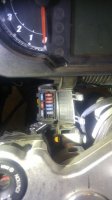tecpatl4
Just got it firing!
I apologize if this has been posted before but I haven't been able to find it.
I have a 2014 Stelvio.
I plugged an air compressor into the 12 v socket, it ran for a second and quit. The compressor still works in my honda, so I assume I blew a fuse. However I cannot find any reference to that anywhere and everything else still works that I can see, including the GPS power.
I don't use the socked themselves but I have a usb charger spliced in on that circuit under the seat.
Also, I'm unable to find the aux fuse box listed in the service manual, it's not under the right hand fairing.
I have a 2014 Stelvio.
I plugged an air compressor into the 12 v socket, it ran for a second and quit. The compressor still works in my honda, so I assume I blew a fuse. However I cannot find any reference to that anywhere and everything else still works that I can see, including the GPS power.
I don't use the socked themselves but I have a usb charger spliced in on that circuit under the seat.
Also, I'm unable to find the aux fuse box listed in the service manual, it's not under the right hand fairing.

